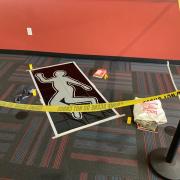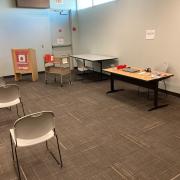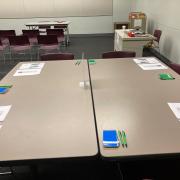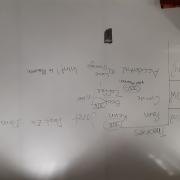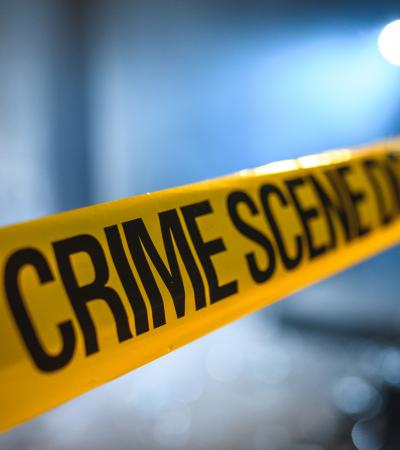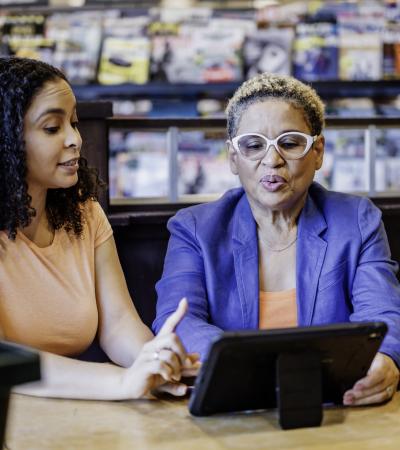Crime Scene Investigation: Deadly Disinformation sought to teach participants how to look out for disinformation by interacting with and solving a mock crime scene.
The program description was as follows: Have you ever wondered what it would be like to work a crime scene and solve a mystery? Now's your chance to channel your inner sleuth and get on the case! Process evidence from a mock crime scene and work in teams to solve whodunit!
This description was intentionally kept vague so that it wouldn’t influence their perceptions of what they think misinformation and disinformation is.
Advanced Planning
This program series was held before the 2022 midterm elections when mis/disinformation was expected to be rampant. The program was intended to get patrons thinking about how information is disseminated and question sources of information. However, staff were aware that patrons were not likely to engage in programs where they were just told what disinformation and misinformation were. It was decided that the participants would be provided with a scene in which they were to make determinations as to what was planted information versus what were honest mistakes.
This program was planned several months in advance with a team of library workers who assisted in crafting the story around the crime scene and creating ”evidence” that would be presented both at the crime scene and during the program. Staff used the names from a previously purchased kit with permission from the company (The Crime Scene Forensic Science Mega Kit: The Missy Hammond Case - 40-Student Pack), but we used the names from a website that was included with the kit. All of the documents were created by staff. The documents included unintentionally misleading information, such as witness statements, and intentionally misleading information as examples of misinformation and disinformation. Canva was used to create most of the documents; however, a fake Facebook post generator was used for the Facebook posts.
Your library can craft a story based on the resources you have available, as well as using the creativity of your team. Be sure to answer who, what, where, how and why. Once you do so, it becomes easier to work out what details can be used to intentionally or inadvertently lead our (private) detectives astray.
Marketing
Marketing is done at least a month in advance, but for summer programming, it often starts earlier. Our marketing team promotes the program via social media, and we use flyers located at each branch to help get the word out.
Attendance for this series varied from branch to branch. There are multiple possibilities for the different sizes of attendees at each branch. These include the timing of the program, marketing reach, size of available space and location of the branch.
Budgeting
We had a small budget to spend. We used the budget to order supplies for creating the crime scene, including crime scene markers, memo pads (for our patrons who served as private investigators), and crime scene tape. We also used the funds to order snacks and drinks. Most of the props we used, however, were from materials we already had in the library (our crime scene location was a library after all), or donations from other staff members.
Day-of-event Activity
Ideally, set up should occur the day before to give yourself time to properly set up the scene. However, due to unavoidable circumstances, some scenes had to be set up in the morning. Yet, since the other branches had an opportunity to see how the setup was located at the Central Branch, they were able to quickly reset it at their branches, making necessary changes based on the space available.
Altogether, we had a team of at least eight with the assistance of various volunteers to assist in keeping an eye on patrons while they were examining the crime scene and others who kept watch of those who were still waiting to enter the ”crime scene." Since we had limited room to allow all participants to enter the crime scene, we would advise to limit the number of people in the crime scene based on the size of the room. This will allow participants to comfortably move around the room without disturbing the crime scene too much.
It is possible, depending on the space available, to have the crime scene and waiting room area in the same room. Be sure to cordon off the crime scene to where patrons cannot enter unless given permission. It's ideal to have the crime scene in a separate, yet hopefully nearby room, and the waiting area in another room.
The core team consisted of: Alicia Deal, Emily Goodwin, Courtney Hurd, Jesse Blum, Sherry Cortes, Mae Neal, Paige Shank, Jessica Alvarado.
Program Execution
There were 85 attendees across five branches. Due to unavoidable circumstances, such as bad weather, this was less than we were expecting. Some branches required limiting the number of people who could register/attend, because the rooms in which they were held were small. The program lasted two hours to allow patrons enough time to review the crime scene and the evidence documents.
The program was as follows:
As they entered, patrons were given some documents such as fake newspaper clippings and Facebook posts about the crime they would be investigating.
When the program was ready to start, staff explained the instructions for the program, including how they would serve as private detectives and only small groups at a time would be allowed to enter the crime scene. In the meantime, those waiting to enter the crime scene can review the preliminary documents that were handed out to them.
Those who enter the crime scene have roughly 5-8 minutes to review the scene (depending on how many total patrons are attending). They are allowed to touch items and interact with them; however, they must put them back where found.
Once they leave the crime scene, they are given other documents that include witness statements, police reports and toxicology reports.
Once everyone has had a chance to view the crime scene, they are given roughly 30 minutes (depending on the number of people attending) to collaborate and review the evidence to determine what happened and who they think committed the crime.
Roughly 30 minutes before the end of the program, using a whiteboard, staff record patron theories that they share with the group. This also allows for discussion on what they think happened. After the major theories are recorded (the who, what, where, why and how must be answered), there is a vote to choose the most popular theory amongst the group.
After the vote for the most popular theory, staff make the Big Reveal on what actually happened. Toward the end of the program, after the Big Reveal, staff gave a brief overview of mis/disinformation and how it applied to our crime scene.
After the program ends, patrons are instructed to complete a survey, either online via a QR Code that is placed throughout the room or via a physical copy that is handed out to patrons by staff.
We intentionally kept the survey short so as not to overwhelm patrons with the questions, plus to allow them to quickly complete it once the program had ended. We included both a print copy of the program and a QR Code with the survey link so patrons could choose which option they felt most comfortable with.
Survey questions were mostly multiple choice (with one fill in the blank): Did you enjoy the program? Explain what you did or did not enjoy about the program. Are you interested in attending more crime scene programs? What branch did you attend this program?
The response from those who participated was overwhelmingly positive, including how they enjoyed being able to collaborate with the other attendees. Even friendships developed through their participation in the program. Participants also mentioned how they were impacted by the realization of what disinformation and misinformation is and how it can manifest in many different ways, specifically, in our case as depicted via crime and the criminal justice system.
Advice
Be creative! You don’t have to follow the mock crime narrative that we did. Just be sure to include opportunities for eyewitnesses and evidence to present as contradictory to the actual ”events” of the crime. This means to be sure that there is evidence and/or eyewitness statements that are either intentional lying/covering up (such as a criminal making statements to divert suspicion away from themselves) or that are accidentally misleading or confused (such as when an eyewitness mixes up the dates or times of events).
Also, when placing the evidence, be sure to include evidence that was initially overlooked by the police that the attendees will be able to find.
Supporting Materials
- Feedback (Coming Soon!)
- Programming Librarian Facebook Group



